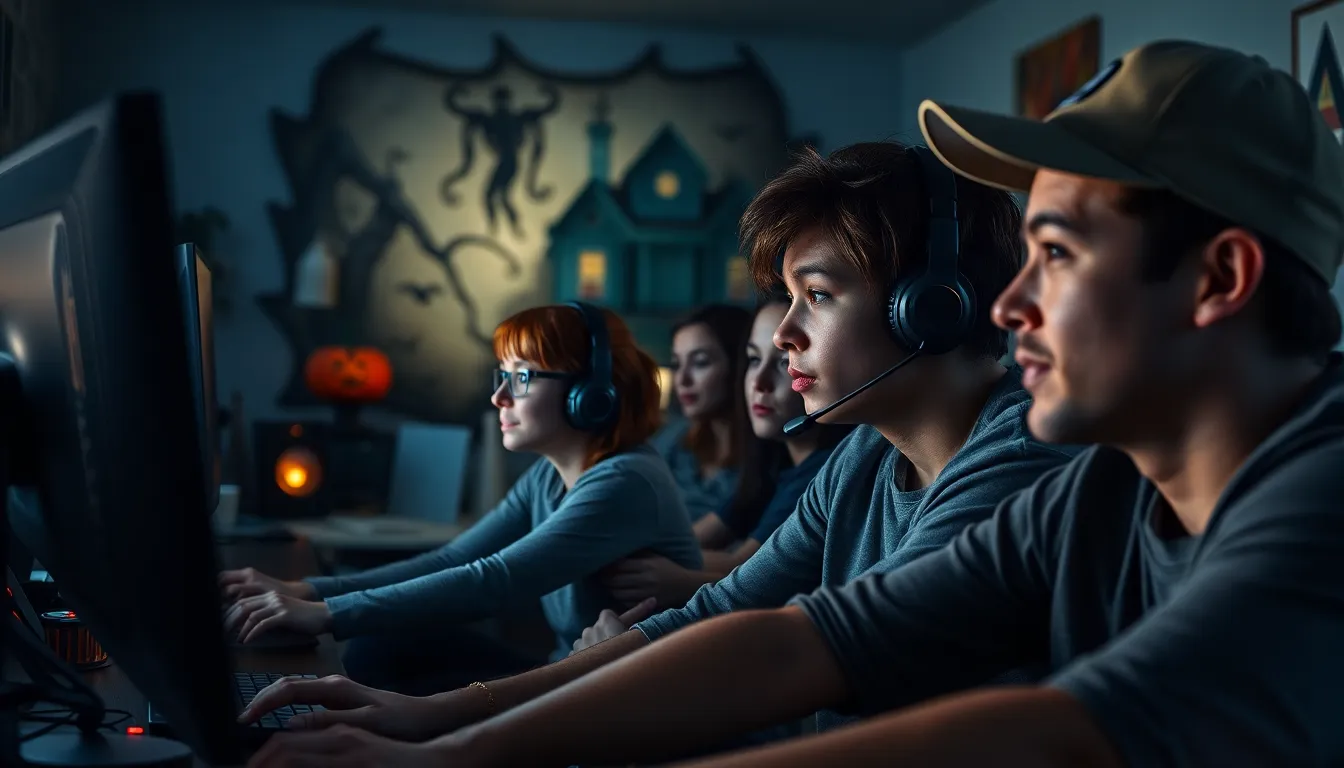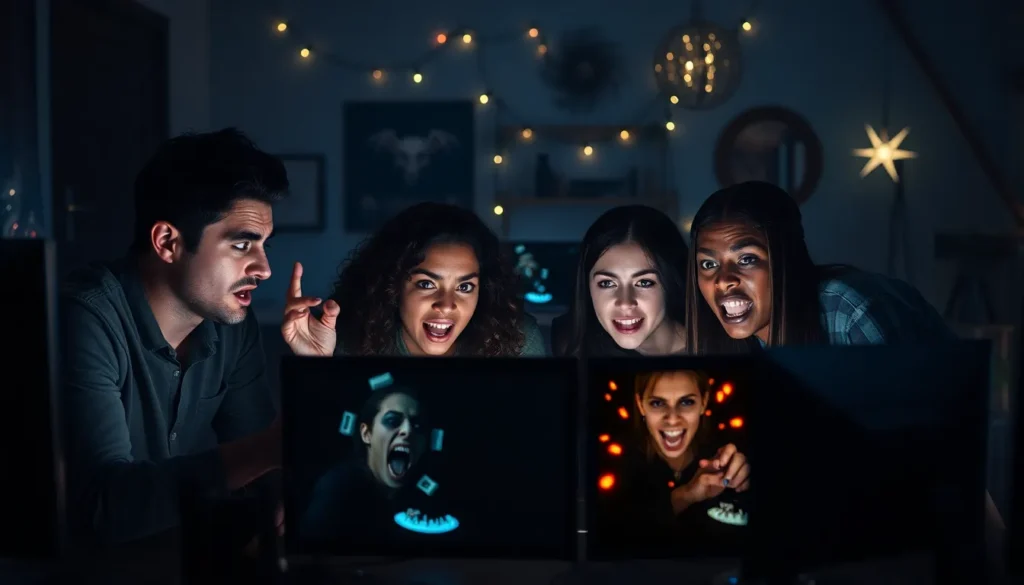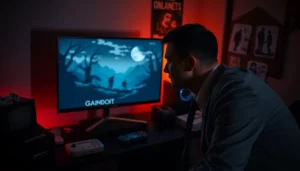Table of Contents
ToggleMultiplayer horror games have taken the gaming world by storm, blending adrenaline-pumping scares with the thrill of teamwork or competition. Players find themselves navigating dark environments filled with terrifying creatures, all while relying on friends or facing off against strangers. This unique genre pushes the boundaries of fear as players experience heart-pounding moments together, creating unforgettable memories.
In this immersive landscape, the social aspect heightens the tension, making every decision crucial. Whether players are collaborating to survive or pitting their wits against each other, the stakes are always high. With a variety of titles available, there’s something for everyone, from those seeking cooperative gameplay to those craving intense PvP action. Dive into the chilling world of multiplayer horror games and discover why they captivate gamers around the globe.
Overview of Multiplayer Horror Games
Multiplayer horror games blend fear with interaction, creating unique experiences that captivate players. These games immerse participants in chilling environments inhabited by horrifying creatures. Players can cooperate or compete, amplifying the suspense through social dynamics.
Variety exists within this genre, accommodating different gameplay styles. Cooperative games, like Phasmophobia and Dead by Daylight, emphasize teamwork while tackling challenges together. Players strategize to survive against menacing foes, fostering camaraderie amidst fear.
Conversely, competitive titles, such as Identity V or Dead by Daylight, heighten tension through adversarial gameplay. Survivors evade a pursuer, testing reflexes and decision-making skills. The intense interactions foster a pulse-pounding atmosphere where each action holds weight.
Notably, the integration of voice chat and communication tools enhances the experience. Players rely on coordination and real-time discussions to overcome obstacles. Social interactions elevate the stakes, making every encounter unpredictable.
Overall, multiplayer horror games offer diverse experiences, thrilling players with a mix of fear, strategy, and engagement. With options available for all types of gamers, the genre appeals to a wide audience eager for adrenaline-fueled adventures.
Popular Multiplayer Horror Games

Multiplayer horror games captivate players with chilling atmospheres and intense gameplay mechanics. Here are a couple of standout titles that exemplify this genre.
Game 1: Phasmophobia and Features
Phasmophobia emphasizes cooperative gameplay, where players assume the roles of ghost hunters investigating haunted locations. Players utilize various tools, including EMF readers, spirit boxes, and thermal cameras, to gather evidence of paranormal activity. The game’s dynamic AI adapts to player actions, creating unique experiences each session. Voice recognition enhances immersion, allowing players to interact with spirits and heightening tension during ghost encounters. The cooperative element fosters teamwork, as players devise strategies to identify different ghost types and perform exorcisms.
Game 2: Dead by Daylight and Features
Dead by Daylight pits survivors against a ruthless killer in a game of cat and mouse. Survivors work together to repair generators while avoiding detection, employing stealth and strategic teamwork to survive. Each character possesses unique perks, adding variety and depth to gameplay. The killer, armed with distinctive abilities, creates a tense atmosphere and challenges players’ reflexes and decision-making skills. Regular updates introduce new characters and maps, ensuring fresh gameplay experiences. The asymmetrical multiplayer format also nurtures a thrilling rivalry, with each match offering unpredictable outcomes.
Gameplay Mechanics
Multiplayer horror games feature diverse gameplay mechanics that enhance the overall experience. Players engage both cooperatively and competitively, heightening the adrenaline rush during encounters with terrifying creatures.
Cooperative Elements
Cooperative multiplayer horror games emphasize teamwork and strategy. Players often assume specific roles, leveraging unique character abilities that complement each other. For instance, in Phasmophobia, players collaborate to gather evidence of supernatural activity while using tools like EMF readers and ghost writing books. Team communication is crucial; players must share information quickly to deduce the ghost type and ensure survival. The immersive atmosphere, coupled with dynamic AI, creates unpredictable challenges that require constant adaptation.
Competitive Elements
Competitive multiplayer horror games focus on adversarial gameplay, where players engage in thrilling cat-and-mouse scenarios. In Dead by Daylight, survivors must coordinate efforts to repair generators while evading a relentless killer. Each survivor possesses unique perks, fostering varied playstyles and strategies. Tension amplifies as players race against time to escape, leading to quick decision-making under pressure. The asymmetrical nature of the game ensures that both survivors and killers experience unique challenges, keeping gameplay fresh and engaging. Regular updates introduce new maps and characters, maintaining player interest and fostering a continuously evolving competitive environment.
The Impact of Multiplayer Experience
Multiplayer horror games significantly enhance player experiences through social interaction and a heightened fear factor. The combination of these elements fosters immersive gameplay that keeps players engaged.
Social Interaction
Multiplayer horror games rely on social interaction to amplify the tension and excitement. Players collaborate or compete, exchanging information, strategies, and emotional responses in real-time. This interaction takes place through voice chat and in-game messaging, enabling teams to coordinate effectively while navigating terrifying environments. Games like Phasmophobia engage players by demanding teamwork and communication; players must share clues and evidence to identify supernatural entities. Dead by Daylight intensifies the experience further, creating rivalries that push players to outmaneuver each other. The need for effective communication drives players to develop trust and camaraderie, enhancing the overall experience and making every encounter more impactful.
Fear Factor
The fear factor in multiplayer horror games plays a critical role in their appeal. The unpredictability of both the game environment and other players heightens anxiety levels. Cooperative games heighten dread as players navigate dark, foreboding spaces filled with lurking threats. In Phasmophobia, players rely on each other to gather evidence while grappling with eerie sounds and sudden scares. Competitive titles, such as Dead by Daylight, elevate the fear factor by pitting survivors against a relentless killer. As players race against time, the constant threat of being hunted creates a palpable sense of urgency. This interplay of fear and decision-making keeps players on edge, leading to unforgettable experiences that resonate long after the game concludes.
Multiplayer horror games have carved a unique niche in the gaming world by blending fear with social interaction. Players find themselves immersed in chilling environments where teamwork or competition heightens the stakes. The diverse range of titles available caters to various player preferences, ensuring that whether one enjoys cooperative strategies or intense rivalries, there’s something for everyone.
As these games continue to evolve with innovative mechanics and engaging narratives, their popularity is likely to grow. The thrill of facing terrifying foes alongside friends or against adversaries creates memorable experiences that resonate long after the game ends. Multiplayer horror games not only challenge players’ skills but also foster connections, making them a compelling choice for those seeking adrenaline-fueled escapades.







